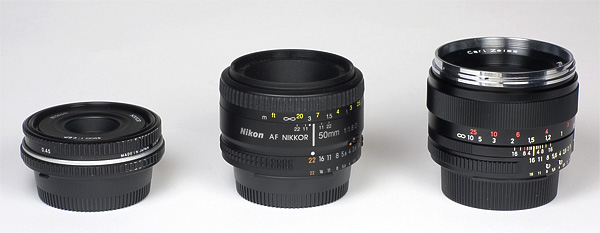|
Nikkor Ai-P 45mm f/2.8 - Review / Lab Test Report |
|
Lens Reviews -
Nikon / Nikkor (APS-C)
|
|
Page 1 of 2
Review by Klaus Schroiff, published January 2007
Lens kindly provided for testing purposes by Peter-Cornelius Spaeth!
Introduction
There aren´t really many lenses left out there which could really excite me but the Nikkor
Ai-P 45mm f/2.8 qualifies here. The Pentax folks have lots of ´em whereas
there´s only one (recent) Nikkor and no Canon EF equivalent at all in this category -
it is a so-called pancake lens. The meaning gets pretty obvious when looking
at the lens: it is flat with a "length" of a mere 17mm ... and it is sweet. 8-)

The story behind this lens is pretty interesting because the design is about
as old as photography itself - it is a Tessar and the sound of it already indicates
its origins: Carl-Zeiss. Since its invention in 1902 by Dr. Paul Rudolph more than
100mio. (!) of these lenses were manufactured
(source: Wikipedia).
At the time the idea was simple and efficient - minimize the number of elements
to reduce flare and to increase contrast and center resolution - lens coatings did
not exist till much, much later in the century. Tessars are limited to relatively
slow speeds which is why most manufacturers replaced it by faster but also more
complex designs later on. However, the idea never really went extinct so you can
still find a few Tessar-variants here and there.

In late 2001 Nikon released its latest
interpretation of the story - the Ai-P 45mm f/2.8. It is a manual focus lens but
thanks to a CPU it is compatible with all exposure modes of CPU-controlled
Nikon (D)SLRs. The lens has a dedicated aperture ring but on modern DSLRs you
have to set the lens to automatic aperture so it behaves like a "G" lens here.
Initially the lens was meant as a kit lens for the Nikon FM3A but it was also available
separately. "Was" because unfortunately Nikon decided to discontinue the lens
recently but you may still find it in shops here and there if you´re lucky. Naturally
cuteness itself is no application for a lens and f/2.8 is slow by today´s normal
lens standards - probably a reason why this Nikkor didn´t find many new friends
except collectors and photographers seeking for a super-compact setup (outdoor, street photography).
The D200 as shown above is probably no perfect match for this lens but something like
a D40 would be able to compete with some of the bigger digicams size-wise.
Here´s a visual comparison between the Ai-P 45mm f/2.8, AF 50mm f/1.8D and the
new Zeiss ZF 50mm f/1.4.

Thanks to a full-metal construction is the build quality is excellent.
The tiny focus ring operates smooth and it is well-damped like in the good
´ol times. As you can see in the product shots it extends/retracts slightly
when changing focus. The front element does not rotate so using a polarizer
is no problem. A micro-hood is also part of the package.
| Specifications |
|---|
| Equiv. focal length | 67.5 mm (full format equivalent) |
| Equiv. aperture | f/4.2 (full format equivalent, in terms of depth-of-field) |
| Optical construction | 4 elements in 3 groups |
| Number of aperture blades | 7 (rounded) |
| min. focus distance | 0.45 m (max. magnification ratio 1:7.6) |
| Dimensions | 62 x 17 mm |
| Weight | 120 g |
| Filter size | 52 mm (non-rotating) |
| Hood | Nikon HN-35 (included), barrel shaped (screw-in) |
| Other features | manual focus only. Compatible to all Nikon DSLRs thanks to CPU. |
|